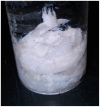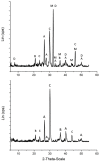Serpentinization-Associated Mineral Catalysis of the Protometabolic Formose System
- PMID: 37374080
- PMCID: PMC10303151
- DOI: 10.3390/life13061297
Serpentinization-Associated Mineral Catalysis of the Protometabolic Formose System
Abstract
The formose reaction is a plausible prebiotic chemistry, famed for its production of sugars. In this work, we demonstrate that the Cannizzaro process is the dominant process in the formose reaction under many different conditions, thus necessitating a catalyst for the formose reaction under various environmental circumstances. The investigated formose reactions produce primarily organic acids associated with metabolism, a protometabolic system, and yield very little sugar left over. This is due to many of the acids forming from the degradation and Cannizaro reactions of many of the sugars produced during the formose reaction. We also show the heterogeneous Lewis-acid-based catalysis of the formose reaction by mineral systems associated with serpentinization. The minerals that showed catalytic activity include olivine, serpentinite, and calcium, and magnesium minerals including dolomite, calcite, and our Ca/Mg-chemical gardens. In addition, computational studies were performed for the first step of the formose reaction to investigate the reaction of formaldehyde, to either form methanol and formic acid under a Cannizzaro reaction or to react to form glycolaldehyde. Here, we postulate that serpentinization is therefore the startup process necessary to kick off a simple proto metabolic system-the formose protometabolic system.
Keywords: chemical complexity; chemical evolution; chemical garden; formose reaction; hydrothermal environments; metabolism; prebiotic chemistry; serpentinization; systems chemistry.
Conflict of interest statement
The authors declare no conflict of interest.
Figures






Similar articles
-
Plausibility of the Formose Reaction in Alkaline Hydrothermal Vent Environments.Orig Life Evol Biosph. 2023 Jun;53(1-2):113-125. doi: 10.1007/s11084-020-09599-5. Epub 2020 Sep 15. Orig Life Evol Biosph. 2023. PMID: 32749559
-
Environmental History is Transferred via Minerals Altering Formose Reaction Pathways.Angew Chem Int Ed Engl. 2025 Jun 2;64(23):e202504659. doi: 10.1002/anie.202504659. Epub 2025 Mar 27. Angew Chem Int Ed Engl. 2025. PMID: 40116706 Free PMC article.
-
The Messy Alkaline Formose Reaction and Its Link to Metabolism.Life (Basel). 2020 Jul 28;10(8):125. doi: 10.3390/life10080125. Life (Basel). 2020. PMID: 32731352 Free PMC article.
-
Catalytic formation of monosaccharides: from the formose reaction towards selective synthesis.ChemSusChem. 2014 Jul;7(7):1833-46. doi: 10.1002/cssc.201400040. Epub 2014 Jun 16. ChemSusChem. 2014. PMID: 24930572 Review.
-
Quantifying Catalysis at the Origin of Life.Chemistry. 2023 Sep 21;29(53):e202301447. doi: 10.1002/chem.202301447. Epub 2023 Aug 14. Chemistry. 2023. PMID: 37578090 Review.
Cited by
-
The Origin of RNA and the Formose-Ribose-RNA Pathway.Int J Mol Sci. 2024 Jun 19;25(12):6727. doi: 10.3390/ijms25126727. Int J Mol Sci. 2024. PMID: 38928433 Free PMC article. Review.
-
The second wave of formose research.BBA Adv. 2025 Jan 17;7:100141. doi: 10.1016/j.bbadva.2025.100141. eCollection 2025. BBA Adv. 2025. PMID: 39974666 Free PMC article.
-
A New Mechanism for Formation of Glycine from Glyoxylic Acid: the Aza-Cannizzaro Reaction.Chemistry. 2024 Dec 18;30(71):e202403202. doi: 10.1002/chem.202403202. Epub 2024 Nov 6. Chemistry. 2024. PMID: 39349361 Free PMC article.
References
-
- Yadav M., Yadav H.S., editors. Biochemistry: Fundamentals and Bioenergetics. Bentham Science Publishers; Sharjah, United Arab Emirates: 2021.
-
- Breslow R. On the mechanism of the formose reaction. Tetrahedron Lett. 1959;1:22–26. doi: 10.1016/S0040-4039(01)99487-0. - DOI
LinkOut - more resources
Full Text Sources

